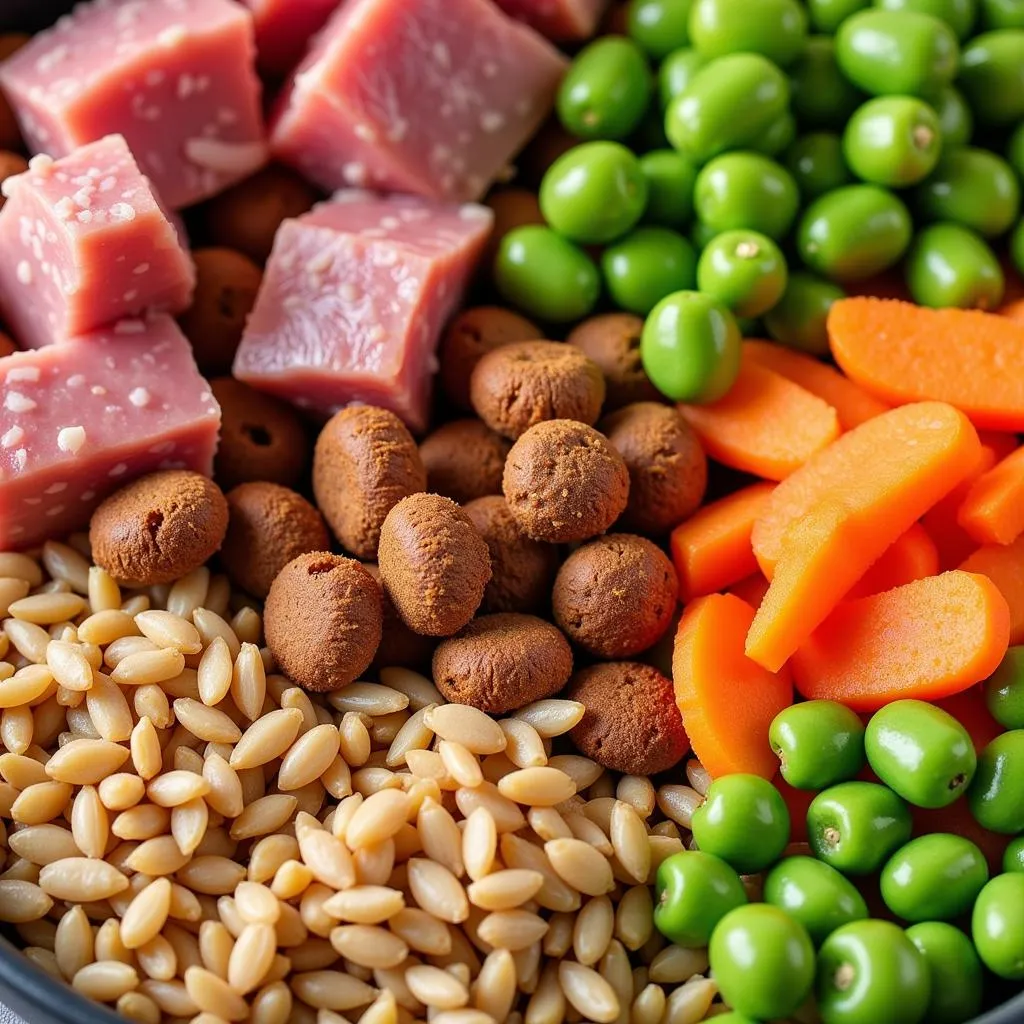The quest for the “Best Choice Dog Food” can feel like navigating a labyrinth of kibble mountains and wet food rivers. With countless brands boasting miraculous benefits and confusing ingredient lists, how do you separate the marketing hype from the food that truly nourishes your furry friend?
 Golden Retriever enjoying a bowl of dog food
Golden Retriever enjoying a bowl of dog food
Decoding Your Dog’s Dietary Needs
Just like humans, dogs thrive on a balanced diet tailored to their specific needs. Age, breed, size, activity level, and even pre-existing health conditions all play a crucial role in determining the optimal nutritional profile for your canine companion.
Puppies: Fueling Growth and Development
Puppies, bursting with energy and growing at lightning speed, require a higher calorie intake than adult dogs. Look for optima dog food specifically formulated for puppies, with higher protein content to support muscle development and essential fatty acids like DHA for brain and vision health.
Adult Dogs: Maintaining Optimal Health
Once your furry friend reaches adulthood, their dietary needs shift towards maintaining a healthy weight and supporting their activity level. High-quality protein remains essential, while the right balance of carbohydrates and fats provides sustained energy for daily adventures.
Senior Dogs: Supporting Golden Years
As dogs age, their metabolism slows down and they become more susceptible to certain health issues. Senior dog food formulas often contain fewer calories to prevent weight gain and may include joint-supporting ingredients like glucosamine and chondroitin.
Navigating the Ingredient List: A Pet Parent’s Guide
Choosing the best choice dog food starts with understanding what goes into it. Here’s a breakdown of key ingredients to look for – and some to avoid:
Essential Ingredients:
- Named Meat Sources: The first ingredient should always be a specific protein source like chicken, beef, or fish, rather than generic terms like “meat meal.”
- Whole Grains (Optional): While some dogs thrive on grain-free diets, others benefit from the fiber and nutrients in whole grains like brown rice or oatmeal.
- Healthy Fats: Omega-3 and omega-6 fatty acids, found in fish oil and flaxseed, contribute to healthy skin, coat, and cognitive function.
- Fruits and Vegetables: These provide essential vitamins, minerals, and antioxidants for overall well-being.
Ingredients to Avoid:
- Artificial Colors, Flavors, and Preservatives: These additives offer no nutritional value and may even be harmful to your dog’s health.
- By-Products: These are rendered parts of animal carcasses deemed unfit for human consumption and offer little nutritional value.
- Fillers: Ingredients like corn, wheat, and soy are often used as inexpensive fillers but provide minimal nutritional benefit.
 Close-up of dog food ingredients
Close-up of dog food ingredients
What About Open Raw Dog Food?
Raw food diets have gained popularity in recent years, and for good reason. Proponents tout the benefits of feeding dogs a diet closer to what their wild ancestors consumed, citing potential improvements in skin and coat health, digestion, and energy levels.
However, it’s important to approach raw feeding with caution. Raw meat can harbor harmful bacteria, posing a risk to both dogs and humans if not handled properly. Additionally, formulating a balanced raw diet requires careful research and planning to ensure your dog receives all the necessary nutrients.
Beyond the Bowl: Factors to Consider
Choosing the best choice dog food goes beyond just reading labels.
Lifestyle and Activity Level
A sedentary lapdog’s caloric needs will differ significantly from those of a high-energy working breed. Adjust the type and amount of food accordingly to prevent obesity or weight loss.
Allergies and Sensitivities
Food allergies are common in dogs, often manifesting as skin irritations, digestive issues, or ear infections. If you suspect your dog has a food allergy, consult your veterinarian for proper diagnosis and dietary recommendations. You might consider switching to a limited-ingredient diet or a formula specifically designed for sensitive stomachs.
Budget
High-quality dog food comes at a price, but it’s an investment in your furry friend’s long-term health and well-being. Set a realistic budget and prioritize ingredients over marketing gimmicks.
Recognizing a Healthy Diet: Signs Your Dog is Thriving
- Shiny, healthy coat
- Clear eyes
- Consistent energy levels
- Healthy weight
- Regular, firm stools
If you notice any negative changes in your dog’s health after switching foods, consult your veterinarian.
Frequently Asked Questions
1. How much should I feed my dog?
Feeding guidelines vary depending on factors like age, breed, activity level, and the specific food you choose. Consult your veterinarian or refer to the feeding guide on your chosen dog food bag for recommendations.
2. Can I give my dog human food?
While some human foods are safe for dogs in moderation, others can be toxic. Avoid feeding your dog grapes, raisins, onions, chocolate, caffeine, alcohol, and anything high in fat or sugar.
3. What about treats?
Treats can be a valuable tool for training and bonding, but they should make up no more than 10% of your dog’s daily caloric intake.
4. My dog has bad breath. Could it be their food?
Dog food for bad breath can help. Dental hygiene plays a significant role in a dog’s breath. Regular brushing and dental chews can help reduce plaque and tartar buildup.
5. What are the signs of a food allergy in dogs?
Common signs of food allergies include itchy skin, gastrointestinal upset (vomiting, diarrhea), ear infections, and excessive licking or chewing of the paws.
Conclusion
Choosing the best choice dog food is a journey unique to every pet parent. By understanding your dog’s individual needs, deciphering ingredient lists, and prioritizing quality nutrition, you can provide your furry companion with the foundation for a long, healthy, and vibrant life.
For support in finding the perfect food for your canine companion, don’t hesitate to reach out to our team at Mina Cones Food. Call us at 02437655121, email us at minacones@gmail.com, or visit us at 3PGH+8R9, ĐT70A, thôn Trung, Bắc Từ Liêm, Hà Nội, Việt Nam. We’re here to help you navigate the world of pet nutrition with confidence!